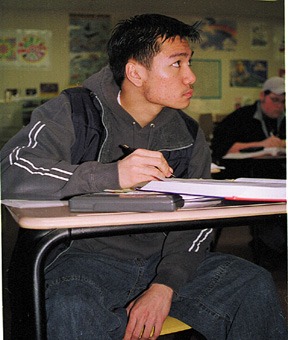AP classes get a boost in Oak Harbor
By P. CHRISTINE SMITH
Staff reporter
Oak Harbor High School has a new chunk of money to devote to advanced placement courses, thanks to the grant-writing efforts of two teachers.
And, the money is being used to help prepare more of the student population to take the popular high level courses.
“I’ve always thought that the harder classes I take now will pay off in the future,” said Jake Scarbrough, an 18-year-old senior. This year he is taking AP calculus and AP American literature, and he is exposed to classwork and assignments that he wouldn’t have in regular classes, which has prepared him for college.
AP classes, Scarbrough said, will also help a student “to get into the really, really good schools.”
This senior has maintained a “really good” grade-point average and has taken just about every honors and AP class available at the high school. Scarbrough said he only wishes the school had been able to offer more.
Now, that wish is coming through thanks to the new grant. Nicole MacTavish, a ninth-grade English teacher and the school’s Associated Student Body advisor, and Dwight Lundstrom, a math teacher of pre-calculus and algebra classes, successfully garnered the nearly $10,000 grant from the Advanced Placement Incentive Program from the state.
The pair wrote the grant as part of the requirements from the administrators’ certificate program in which they are enrolled at Western Washington University. The two will receive their certificates, which credit-wise is equivalent to a master’s degree, this May. They will then be qualified for assistant principal or principal positions.
Both MacTavish and Lundstrom agree that AP classes are an important opportunity for high school students. AP classes, which are college-level in both the material covered and the expectations placed upon students, push kids harder and prepare them for college.
“The real incentive is the challenge,” MacTavish said.
Additionally, upon the completion of an AP course, students take a test. Proficiency on the test may result in college credit and, as a result, a considerable savings in college tuitition.
The grant money, which the district has already received, will pay to send four or five teachers, who will be teaching new AP classes, to an AP training institute. Teachers of AP classes are required to complete the additional teacher training prior to taking on an AP class. Additionally, some of the funding will also go to training other teachers in the various departments in an effort to prepare students in the early high school years to take AP classes in their senior year. This team approach to teaching is called a vertical team, MacTavish and Lundstrom said.
The vertical team approach will help all students prepare for AP classes. However, it is hoped that under-represented students will benefit the most.
“It’s for kids that are minority students … to get more of them involved in AP classes,” Lundstrom said. “And the way we want to do that is through training in classrooms in the earlier years, to kind of raise expectations in our other course curriculum.”
“We’re trying to build vertical teams in each of the departments so that the freshman program leads into the 10th grade, which leads into the junior program,” and then into advanced placement courses, MacTavish said.
MacTavish was previously trained to teach AP classes.
Some students have been unable to take AP classes because they entered high school without the necessary prerequisites to put them on track for AP classes later. In order for a student to take AP calculus as a senior, for example, he or she must take geometry as a freshman, which means algebra had to have been completed at the eighth grade level.
“It was happening especially to minority kids,” Lundstrom said.
A new AP course, statistics, will allow these students to take an advanced placement math class.
“The AP statistics offers an advanced placement course to them after Algebra II, rather than having to take that one more step,” Lundstrom said.
Minority students have been better represented in advanced placement U.S. History, as demonstrated by the number of minority students in this AP class being in line, percentage-wise, with the school’s total population, Lundstrom said.
“And the reason they’re able to do that is there wasn’t as many prerequisites,” Lundstrom said.
But, because fewer prerequisites were required, the students were sometimes struggling in this course.
“The whole department has to be on board with specific teaching strategies. So that’s where the vertical teaching teams are,” MacTavish said. “No matter what course you teach, there are going to be opportunities for staff development and staff meetings so that all teachers can participate in some of the specific teaching strategies.”
Oak Harbor High School offers AP classes in math, English and U.S. history. Plans are in place to expand AP class offerings to statistics and U.S. government with the start of next school year.



